1. Place the PPP establishment steps in the correct order by dragging each step to the appropriate sequence number on the right.
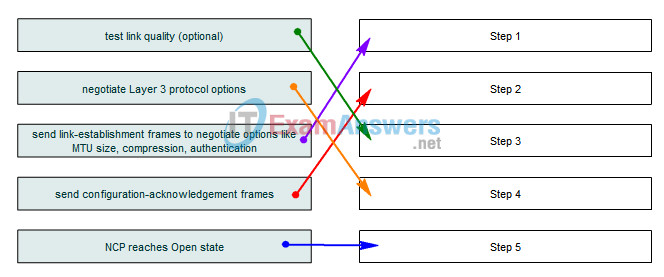
2. Which output from the show interfaces s0/0/0 command indicates that the far end of a point-to-point link has a different encapsulation set than the local router?
- serial 0/0/0 is down, line protocol is down
- serial 0/0/0 is up, line protocol is down
- serial 0/0/0 is up, line protocol is up (looped)
- serial 0/0/0 is up, line protocol is down (disabled)
- serial 0/0/0 is administratively down, line protocol is down
3. What is the default encapsulation for serial interfaces on a Cisco router?
- HDLC
- PPP
- Frame Relay
- X.25
4. What is the function of the protocol field in a PPP frame?
- It identifies the application layer protocol that will process the frame.
- It identifies the transport layer protocol that will process the frame.
- It identifies the data link layer protocol encapsulated in the data field of the frame.
- It identifies the network layer protocol encapsulated in the data field of the frame.
5. Drag the term on the left to the associated description on the right. Not all options are used.

6. Which three statements describe the function of time-division multiplexing. (Choose three.)
- Multiple data streams share one common channel.
- Bit interleaving controls the timing mechanism that places data on the channel.
- Time slots are utilized on a first-come, first-served basis.
- Statistical time-division multiplexing (STDM) was developed to overcome the inefficiency caused by time slots still being allocated, even when the channel has no data to transmit.
- Sources of data alternate during transmission and are reconstructed at the receiving end.
- Priority can be dedicated to one data source.
7. What describes the serial connection between two routers using the High-Level Data Link Control (HDLC) protocol?
- synchronous or asynchronous bit-oriented transmissions using a universal frame format
- synchronous bit-oriented transmissions using a frame format that allows flow control and error detection
- asynchronous bit-oriented transmissions using a frame format derived from the Synchronous Data Link Control (SDLC) protocol
- asynchronous bit-oriented transmissions using a V.35 DTE/DCE interface
8. If an authentication protocol is configured for PPP operation, when is the client or user workstation authenticated?
- prior to link establishment
- during the link establishment phase
- before the network layer protocol configuration begins
- after the network layer protocol configuration has ended
9. Why are Network Control Protocols used in PPP?
- to establish and terminate data links
- to provide authentication capabilities to PPP
- to manage network congestion and to allow quality testing of the link
- to allow multiple Layer 3 protocols to operate over the same physical link
10. Which statement describes the PAP authentication protocol?
- It sends encrypted passwords by default.
- It uses a two-way handshake to establish identity.
- It protects against repeated trial-and-error attacks.
- It requires the same username to be configured on every router.
11. A technician testing functionality of a recently installed router is unable to ping the serial interface of a remote router. The technician executes the show interface serial0/0 command on the local router and sees the following line in the router:
Serial0/0 is down, line protocol is down
What are two possible causes for this command output? (Choose two.)
- clockrate command missing
- carrier detect signal not sensed
- keepalives not being sent
- interface disabled due to high error rate
- interface shutdown
- cabling is faulty or incorrect
12. The network administrator is configuring Router1 to connect to Router2 using a three-way handshake authentication. Drag the commands necessary to configure Router1 from the left to the appropriate description on the right. Not all options are used.
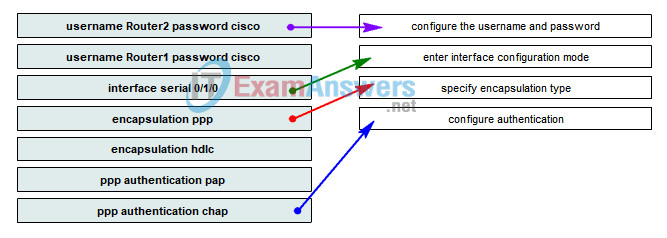
13. What is required to successfully establish a connection between two routers using CHAP authentication?
- The hostnames of both routers must be the same.
- The usernames of both routers must be the same.
- The enable secret passwords configured on both routers must be the same.
- The password configured with the username of the router must be the same on both routers.
- The ppp chap sent-username command must be configured the same on both routers.
14. Match each characteristic on the left with the appropriate authentication protocol on the right.
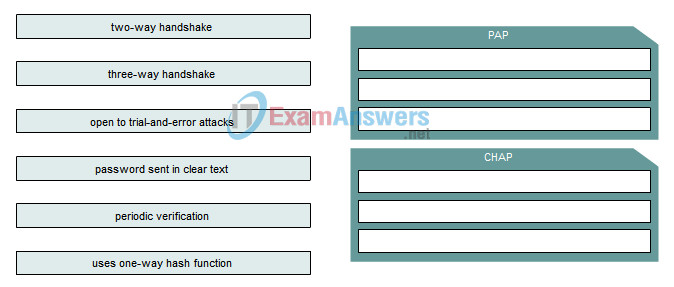
Answer
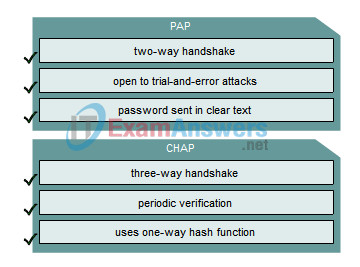
15. Drag the description on the left to the appropriate protocol on the right. Not all options are used.
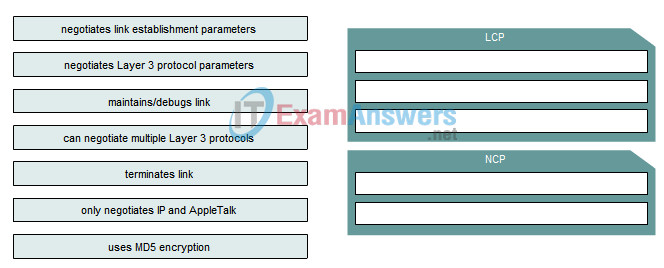
Answer

